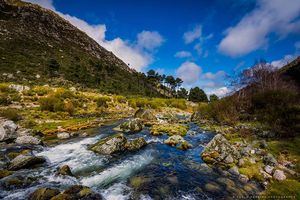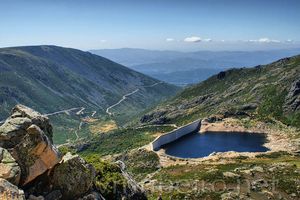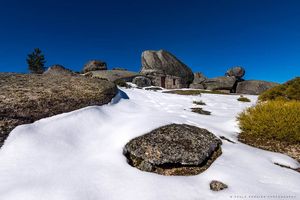
Serra da Estrela, Portugal
Discover the allure of the most beautiful mountains in Portugal.
Serra da Estrela’s Natural Park (commonly known as Serra da Estrela) is a vast area of natural and cultural interest. It is the largest protected area in the country of Portugal (approximately 1011 square miles) and is situated mostly in the District of Guarda (the remaining area being part of the District of Castelo Branco).
It contains several towns such as: Covilhã, Manteigas, Gouveia, Seia, Celorico da Beira and Guarda.
Its landscape is characterized by high boulders scattered along the mountain, with icy rivers flowing through them. Historically, the water in the rivers was used to provide hydroelectric power in order to assist in the production (spinning and weaving) of wool. Currently, the shepherds still keep their herds in the Serra, although grazing is a moribund activity, supplanted by an economy focused on tourism.
The highest point of continental Portugal (1993 meters tall) lies at the heart of the Natural Park, the famous "Torre". It offers unique opportunities for hiking and climbing, making it one of the most appealing destinations for lovers of adventure and sport.
The typical products of Serra da Estrela are its cheese and wool (both from sheep in the region), and the "Serra da Estrela dogs", an indigenous breed characterized by being a proficient protector of the mountain and guiding the flocks.
Facilities at the Park are distributed by Manteigas (central), Seia, Gouveia, and Guarda, where tourist information is available. There are some tourist guides such as "Discovering the Region of Serra da Estrela" (4.25€) with historical observations and the basics about flora and fauna of the region. Recently, it was open the Interpretation Center of Serra da Estrela in Seia, with a natural and cultural exhibit.
When visiting Serra you should always come well prepared. Summer is a season of extremes: hot days give way to cold nights. In winter, the temperature can reach minus 10 degrees and snow covers the surfaces. Sometimes strong wind storms can occur without any prior notice.
Some top spots you must visit while passing through this region are: the Tower, the Wool Museum, Poço do Inferno waterfall, thermal baths, the Abel Manta Museum of Modern Art , Toy Museum and the Interpretation Center of Serra da Estrela.
How to get:
Here you may find some tips on how to reach Serra da Estrela.
By Car:
If you choose to go by car to the mountains, you should bear in mind that the journey is demanding and tiring. This is because of the weather in winter time, which is rarely favorable for driving. The roads may be wet, with ice or snow so we advise you to have your vehicle well prepared (check the car’s conditions before going on the journey and get snow chains for the wheels if necessary.) Drive carefully and at a moderate speed. The N232 road that connects Gouveia and Manteigas is one of the most wind-battered roads in Portugal.
By Bus:
You may travel by express buses which go up the mountains and circulate daily from various locations: Coimbra to Seia, Guarda and Covilhã; Aveiro, Porto and Lisbon to Covilhã. Prices vary between 10 and 15 euros.
There are also some, less regular bus services around the Parque Natural da Serra da Estrela (no direct link.)
Mapa Interactivo:
Serra da Estrela
What to see:
- Covilhã
- Igreja de Santa Maria Church of Covilhã
- Museu de Lanifícios (Wool Museum)
- Manteigas
- Poço do Inferno Waterfall
- Termas de Caldas de Manteigas
- Gouveia
- Abel Manta Museum of Modern Art
- Seia
- Museu do Pão (Museum of Bread)
- Museu do Brinquedo (Toy Museum)
- Serra da Estrela Interpretation Centre
- Torre
- Natural Museum of Electricity
Museums
What to do:
Other worth-visiting nearby towns and cities:
Why "Portugal Travel"?
Portugal Travel is an organization of Portuguese agencies whose objectives are:
- ✓ To make Portugal, its culture and its heritage known.
- ✓ To promote sustainable tourism.
In collaboration with:
Escola Superior de Hotelaria e Turismo do Estoril
Turismo de Portugal
Copyright PortugalTravel.org © - All rights reserved.






